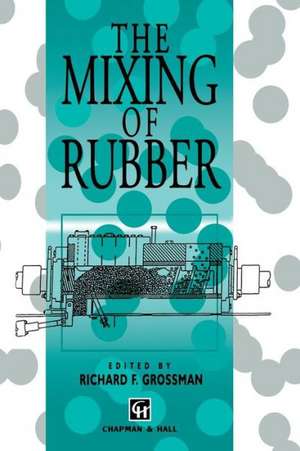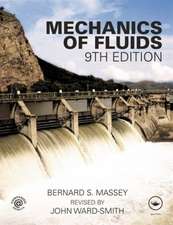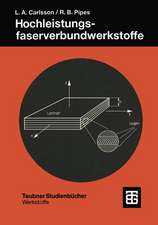The Mixing of Rubber
Editat de R.F. Grossmanen Limba Engleză Paperback – 27 sep 2012
| Toate formatele și edițiile | Preț | Express |
|---|---|---|
| Paperback (1) | 998.68 lei 6-8 săpt. | |
| SPRINGER NETHERLANDS – 27 sep 2012 | 998.68 lei 6-8 săpt. | |
| Hardback (1) | 946.24 lei 6-8 săpt. | |
| SPRINGER NETHERLANDS – 31 mai 1997 | 946.24 lei 6-8 săpt. |
Preț: 998.68 lei
Preț vechi: 1217.90 lei
-18% Nou
Puncte Express: 1498
Preț estimativ în valută:
191.10€ • 200.19$ • 158.38£
191.10€ • 200.19$ • 158.38£
Carte tipărită la comandă
Livrare economică 09-23 aprilie
Preluare comenzi: 021 569.72.76
Specificații
ISBN-13: 9789401064606
ISBN-10: 9401064601
Pagini: 264
Ilustrații: XVII, 242 p.
Dimensiuni: 155 x 235 x 14 mm
Greutate: 0.41 kg
Ediția:Softcover reprint of the original 1st ed. 1997
Editura: SPRINGER NETHERLANDS
Colecția Springer
Locul publicării:Dordrecht, Netherlands
ISBN-10: 9401064601
Pagini: 264
Ilustrații: XVII, 242 p.
Dimensiuni: 155 x 235 x 14 mm
Greutate: 0.41 kg
Ediția:Softcover reprint of the original 1st ed. 1997
Editura: SPRINGER NETHERLANDS
Colecția Springer
Locul publicării:Dordrecht, Netherlands
Public țintă
ResearchCuprins
1 Mixing machinery for rubber.- 1.1 Introduction.- 1.2 Two-roll mills.- 1.3 Internal batch mixers.- 1.4 Continuous mixers.- 1.5 Development of the Banbury mixer.- 1.6 Operating variables.- 2 Mixing cycles and procedures.- 2.1 Cost of internal mixing.- 2.2 Unit operations in mixing.- 2.3 Single-pass versus multiple-pass mixing.- 2.4 Types of mix cycle.- 2.5 Analysis of changes to the mix procedure.- References.- 3 Mill mixing.- 3.1 Introduction.- 3.2 Acceleration of first-pass compound.- 3.3 Mill mixing of specialty compounds.- 3.4 Acceleration in line with internal mixing.- 4 Quality control and the mixing process.- 4.1 Introduction.- 4.2 Testing of raw materials.- 4.3 Control of composition.- 4.4 Tracking the mix cycle.- 4.5 Compound testing.- 5 Statistical process control for industrial mixing.- 5.1 Introduction.- 5.2 Basic SPC charting.- 5.3 Rheometer data and its meaning.- 5.4 A case history.- 5.5 Summary.- 5.6 Mixing control software.- References.- 6 Additives that affect mixing.- 6.1 Introduction.- 6.2 Peptizers in natural rubber.- 6.3 Peptizers in SBR.- 6.4 Peptizers in sulfur-containing polymers.- 6.5 Additives to increase viscosity.- 6.6 Preventing unwanted chemical reactions.- References.- 7 Operation and maintenance of mixing equipment.- 7.1 Inspection of Banbury mixers.- 7.2 Mixer maintenance and lubrication.- 7.3 Anticipating required service.- 7.4 Dust stop maintenance.- 7.5 SSA dust stops.- 7.6 Banbury mixer: hydraulic dust stops.- 8 Mixing procedures for specific compounds.- 8.1 Introduction.- 8.2 EPDM expansion joint cover.- 8.3 Expansion joint intermediate layer.- 8.4 Traffic counter treadle cover.- 8.5 SBR/IR belt cover.- 8.6 EPDM low voltage electrical connector.- 8.7 Peroxide-cured black-filled EPDM compounds.- 8.8 EPDM concrete pipe gasket.- 8.9 SBR insulation.- 8.10 Injection-molded NBR gasket.- 8.11 CR/SBR blend.- 8.12 Low durometer CR/SBR blend.- 8.13 CR specification compounds.- 8.14 Charge-dissipating CR tubing.- 8.15 Nonblack CR for injection molding.- 8.16 Hard rubber industrial wheel.- 8.17 High durometer NBR masterbatch.- 8.18 NBR/PVC cable jacket.- 8.19 NBR/PVC/SBR blend.- 8.20 Butyl masterbatch.- 8.21 Butyl masterbatch, heat interacted.- 8.22 Chlorobutyl/NR blend.- 8.23 CSM cord jacket.- 8.24 Nonblack millable urethane.- 8.25 ECO molding compounds.- 8.26 Polyacrylate shaft seal.- 8.27 XLPE insulation.- 8.28 FKM molding compound.- 8.29 Silicone spark plug boot cover.- 9 Mixing wire and cable compounds.- 9.1 Introduction.- 9.2 Tempered water.- 9.3 Power-controlled mixing.- 9.4 Energy conservation.- References.- 10 Mixing ethylene-propylene diene rubber.- 10.1 Introduction.- 10.2 Background of EPDM development.- 10.3 Composition of EPDM elastomers.- 10.4 Variables in EPM and EPDM elastomers.- 10.5 How processing relates to structure and rheology.- 10.6 Practical guidelines for mixing EP elastomers.- 10.7 Summary.- References.- 11 Mixing of tire compounds.- 11.1 Introduction.- 11.2 Rework.- 11.3 Phase mixing.- 11.4 Natural rubber: viscosity reduction.- 11.5 Measurement of mixing efficiency.- References.- 12 Mixing fluoroelastomer (FKM) compounds.- 12.1 Introduction.- 12.2 Special considerations.- 12.3 Raw materials.- 12.4 Typical formulations.- 12.5 Internal mixing.- 12.6 Mill mixing.- 12.7 Summary.- 12.8 Accounting methods.- 13 Continuous mixing.- 13.1 The Farrel continuous mixer.- 13.2 Operating principles of the FCM.- 13.3 Commercial applications for the FCM.- 13.4 The Farrel mixing venting extruder (MVX).- 14 Evaluating the performance of internal mixers.- 14.1 Introduction and literature review.- 14.2Designing the rotor.- 14.3 Analysis of dispersive mixing.- 14.4 Results from synchronous rotors.- References.- Appendix Unit conversion tables and factors.- A.1 Conversion between Fahrenheit and Celsius.- A.2 Conversion of English units to metric units.























